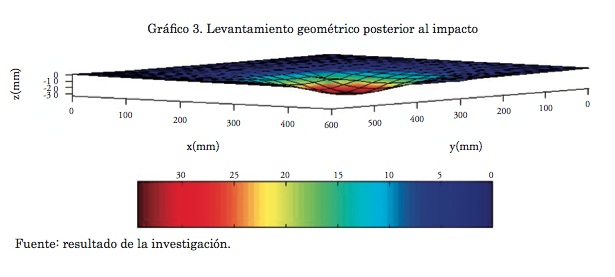Caracterización mecánica y microestructural de acero naval sometido a cargas dinámicas por explosión
Keywords:
grade A ASTM A 131 steel, explosions, plastic deformation, destructive testing, non destructive testing, naval panelsAbstract
The work presents the mechanical and micro-structural characterization of the grade A ASTM A 131 steel laminate that form naval panels (reinforced laminate with defined ratios aspect l/b), attained by means of destructive testing, to establish the mechanical response of naval structures submitted to those types of charges. Measurements of micro-hardness, grain size and tension tests of specimens of the material were carried out before and after the impact. The material hit was selected from structural panels submitted to controlled explosions generated nearby with 25g charges of pentolite, placed at predetermined distances. For the characterization, panels with the presence of fissures were rejected. Important variations in micro-hardness and mechanical characteristics appeared; nevertheless, significant micro-structural changes were not observed in grain size.Downloads
References
Callistter, W. (2003) Materials science and engineering. An introduction. New York, John Wiley & Sons.
Dowling, N. (1999) Mechanical Behavior of materials. New Jersey, Prentice Hall. 2ª ed.
Graham A. & Walsh. (September, 2003). “Potential metallographic technique for the investigation of pipe bombings”, [en línea] en http://www.astm.org/cgi-bin/SoftCart.exe/JOURNALS/FORENSIC/PAGES/4420.htm?E+mystore.
Greaves, R. H. (1979), Metalografía microscópica práctica, Bilbao, Ed. Urmo.
Langdon, G. S.; Chung Kim Yuen S. and Nurick G. N. (January 2005) Experimental and numerical studies on the response of quadrangular stiffened plates. Part III: localised blast loading. International Journal of Impact Engineering; vol. 31, n.º 1, pp. 85-111.
Lamajeyathilagam K., & Vendhan C. P. (July, 2004) “Deformation and rupture of thin rectangular plates subjected to underwater shock”, in Internattional Journal of Impact Engineering, vol. 30, n.º6, pp. 699-719.
Meier, M. (2004) The Hall-Petch Relationship. Department of Chemical Engineering and Materials Science. University of California.
Meyers, M. A. (1994) Dynamic Behavior of Materials.
New York, Ed. John Wiley & Sons Inc.
Neely, J. (2001) Metalurgia y materiales industriales. México, Limusa.
Pochetino, A. (agosto de 2005) “Propiedades mecánicas de los materiales”[ponencia]. III Congreso Internacional de Materiales, (2005). Cartagena de Indias.
Shin,Y. S. (2004) “Ship shock modelling and simulation
for far-field underwater explosion”. Computers & Structures, vol. 82, pp. 2211-2219.
Standard Test Methods for Tension Testing of Metallic
Materials: E 8–00b. ASTM Standards in Building Codes (2000), West Conshohocken, PA, pp. 1-21

Downloads
How to Cite
Issue
Section
License
The authors who publish in this Journal certify that:
- The work submitted for publication in The Ship Science and Technology journal, was written by the author, given that its content is the product of his/her direct intellectual contribution.
- All data and references to material already published are duly identified with their respective credits and are included in the bibliographic notes and quotations highlighted as such.
- All materials submitted for publication are completely free of copyrights; consequently, the author accepts responsibility for any lawsuit or claim related with Intellectual Property Rights thereof, Exonerating of responsibility to The Science and Technology for the Development of Naval, Maritime, and Riverine Industry Corporation, COTECMAR.
- In the event that the article is chosen for publication by The Ship Science and Technology journal, the author state that he/she totally transfers reproduction rights of such to The Science and Technology for the Development of Naval, Maritime, and Riverine Industry Corporation, COTECMAR.
- The authors retain the copyright and transfer to COTECMAR the right of publication and reproduction of the work which will be simultaneously subject to the Creative Commons Attribution License (CC -BY) , which allows the license to copy, distribute, display and represent the work and to make derivative works as long as it recognizes and cites the work in the manner specified by the author or licensor.
- For more information about the Creative Commons Attribution License (CC -BY) and his use and scope, please visit the following web page https://creativecommons.org/licenses/by-sa/4.0/legalcode








